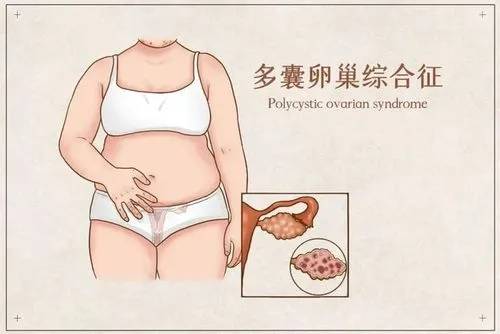Introduction: Having polycystic ovary syndrome can turn a “goddess” into a “tough girl,” not only causing the skin to become rough, more pimples, weight gain, voice coarsening, but also hair growth, hormonal imbalance, and difficulty in getting pregnant. Polycystic ovary syndrome not only affects the beauty of women’s appearance but also leads to “masculinization” symptoms, affecting menstruation and ovulation, resulting in infertility!
What are the symptoms of polycystic ovaries?
First, menstrual irregularities are the main symptoms. It often manifests as infrequent menstruation, irregular cycles, cycles ≥35 days, scanty or absent menstruation; it can also present as irregular uterine bleeding, irregular menstrual cycles, periods, or volume.
Second, infertility. Women of childbearing age often experience infertility due to menstrual irregularities, anovulation, or infrequent ovulation, with menstrual irregularities and infertility being the main reasons for consultation.
Third, hirsutism and obesity. Due to excessive secretion of male hormones in the body, hirsutism and obesity may occur, with male pattern hair distribution. The hirsutism phenomenon may often go unnoticed by patients and is usually detected only during physical examinations.
Fourth, bilateral ovary enlargement. A few patients may have enlarged ovaries 1-3 times larger than normal, palpable during gynecological examinations, but most cases of enlarged ovaries require auxiliary tests such as ultrasound to be detected, as they are not easily felt during clinical examinations.
How does polycystic ovaries affect pregnancy?
During normal ovulation in the ovaries, a group of follicles gradually mature, with the best one releasing an egg. In polycystic ovary syndrome, there are many small follicles that do not mature, leading to no egg release. Insufficient progesterone thickens the uterine lining, and the small follicles secrete androgens, creating a vicious cycle.
Due to the disrupted ovulation function in polycystic patients, anovulation or infrequent ovulation may occur; about 70% experience menstrual irregularities, with main clinical forms being amenorrhea, infrequent menstruation, and dysfunctional uterine bleeding. In severe cases, menstruation may be absent for three to six months, leading to uterine atrophy due to lack of hormonal stimulation.
With fewer and irregular egg releases, coupled with an unfavorable uterine environment, polycystic ovary syndrome is also one of the reasons for difficulty in getting pregnant.
How to conceive with polycystic ovaries?
1. Prepare for pregnancy early
If a woman has polycystic ovary syndrome, it is advisable to start preparing for pregnancy early for better effectiveness. Under normal conditions, women’s optimal pregnancy time is between 23-29 years, while women with polycystic ovary syndrome are better off between 23-26 years.
2. Adjust lifestyle
The most common clinical manifestation in polycystic ovary syndrome is obesity, often accompanied by anovulatory infertility. Therefore, the primary method for obese polycystic patients seeking pregnancy is weight reduction. “Losing weight” can not only regulate hormones, improve reproductive conditions, increase conception rates, but also reduce adverse outcomes for obese pregnant women and significantly improve diabetes and cardiovascular diseases. Adjusting lifestyle should precede inducing ovulation.
3. Psychological adjustment
Undergoing active treatment should never entail negative emotions; face life with an optimistic attitude. Active treatment can effectively alleviate the condition, but it should also be supplemented with a positive mindset, as a cheerful mood is a key factor in helping women with polycystic ovary syndrome transition from expecting mothers to prospective mothers.
4. Ovulation induction therapy
The main symptoms of polycystic women of childbearing age are menstrual irregularities, anovulation, and infertility. Therefore, the main purpose is to treat infertility through various measures, considering ovulation induction therapy under the premise of adjusting hormones.


